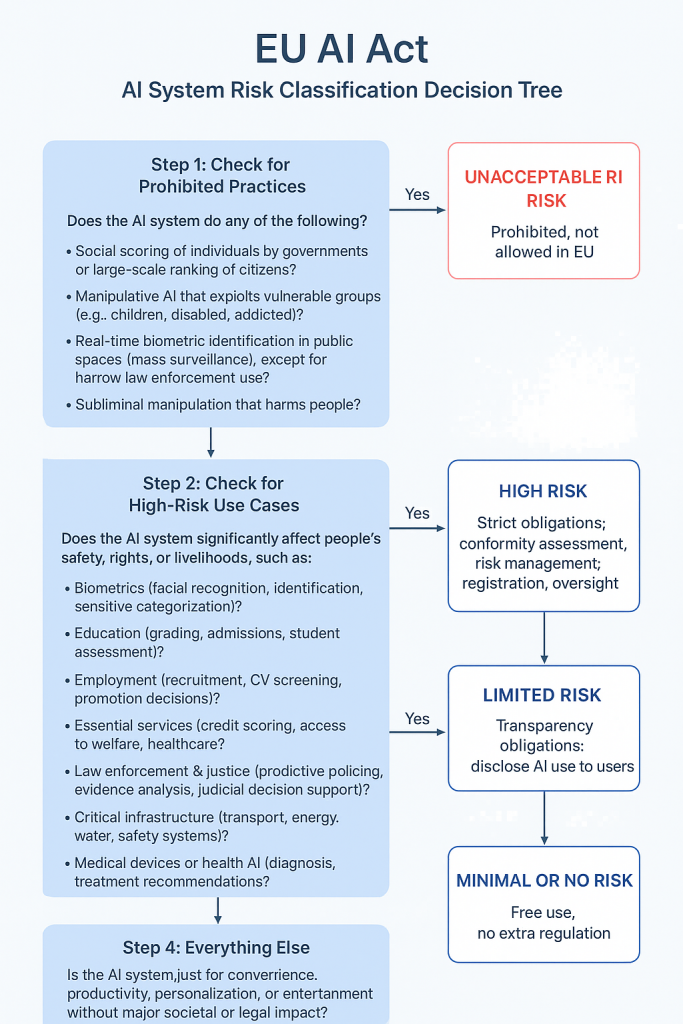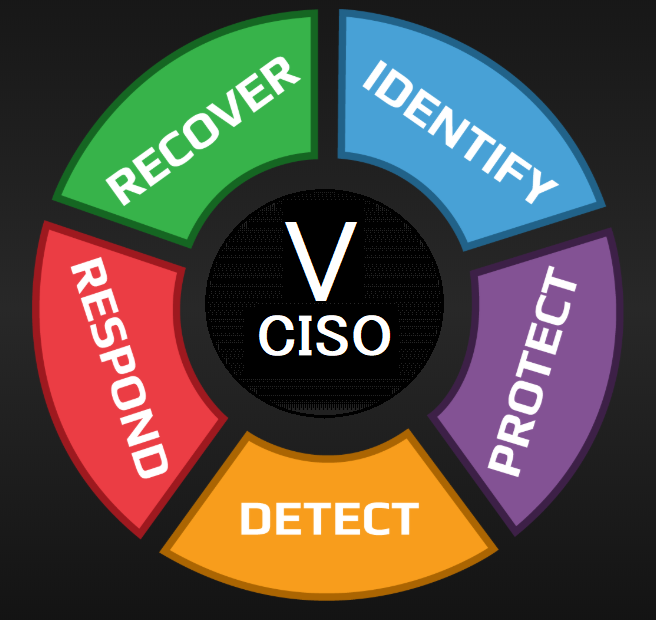A Guide to EU AI Act Compliance
The European Union’s Artificial Intelligence Act represents the world’s first comprehensive regulatory framework for artificial intelligence. As organizations worldwide prepare for compliance, one of the most critical first steps is understanding exactly where your AI system falls within the EU’s risk-based classification structure.
At DeuraInfoSec, we’ve developed a streamlined EU AI Act Risk Calculator to help organizations quickly assess their compliance obligations.🔻 But beyond the tool itself, understanding the framework is essential for any organization deploying AI systems that touch EU markets or citizens.

The EU AI Act’s Risk-Based Approach
The EU AI Act takes a pragmatic, risk-based approach to regulation. Rather than treating all AI systems equally, it categorizes them into four distinct risk levels, each with different compliance requirements:
1. Unacceptable Risk (Prohibited Systems)
These AI systems pose such fundamental threats to human rights and safety that they are completely banned in the EU. This category includes:
- Social scoring by public authorities that evaluates or classifies people based on behavior, socioeconomic status, or personal characteristics
- Real-time remote biometric identification in publicly accessible spaces (with narrow exceptions for law enforcement in specific serious crimes)
- Systems that manipulate human behavior to circumvent free will and cause harm
- Systems that exploit vulnerabilities of specific groups due to age, disability, or socioeconomic circumstances
If your AI system falls into this category, deployment in the EU is simply not an option. Alternative approaches must be found.
2. High-Risk AI Systems
High-risk systems are those that could significantly impact health, safety, fundamental rights, or access to essential services. The EU AI Act identifies high-risk AI in two ways:
Safety Components: AI systems used as safety components in products covered by existing EU safety legislation (medical devices, aviation, automotive, etc.)
Specific Use Cases: AI systems used in eight critical domains:
- Biometric identification and categorization
- Critical infrastructure management
- Education and vocational training
- Employment, worker management, and self-employment access
- Access to essential private and public services
- Law enforcement
- Migration, asylum, and border control management
- Administration of justice and democratic processes
High-risk AI systems face the most stringent compliance requirements, including conformity assessments, risk management systems, data governance, technical documentation, transparency measures, human oversight, and ongoing monitoring.
3. Limited Risk (Transparency Obligations)
Limited-risk AI systems must meet specific transparency requirements to ensure users know they’re interacting with AI:
- Chatbots and conversational AI must clearly inform users they’re communicating with a machine
- Emotion recognition systems require disclosure to users
- Biometric categorization systems must inform individuals
- Deepfakes and synthetic content must be labeled as AI-generated
While these requirements are less burdensome than high-risk obligations, they’re still legally binding and require thoughtful implementation.
4. Minimal Risk
The vast majority of AI systems fall into this category: spam filters, AI-enabled video games, inventory management systems, and recommendation engines. These systems face no specific obligations under the EU AI Act, though voluntary codes of conduct are encouraged, and other regulations like GDPR still apply.
Why Classification Matters Now
Many organizations are adopting a “wait and see” approach to EU AI Act compliance, assuming they have time before enforcement begins. This is a costly mistake for several reasons:
Timeline is Shorter Than You Think: While full enforcement doesn’t begin until 2026, high-risk AI systems will need to begin compliance work immediately to meet conformity assessment requirements. Building robust AI governance frameworks takes time.
Competitive Advantage: Early movers who achieve compliance will have significant advantages in EU markets. Organizations that can demonstrate EU AI Act compliance will win contracts, partnerships, and customer trust.
Foundation for Global Compliance: The EU AI Act is setting the standard that other jurisdictions are likely to follow. Building compliance infrastructure now prepares you for a global regulatory landscape.
Risk Mitigation: Even if your AI system isn’t currently deployed in the EU, supply chain exposure, data processing locations, or future market expansion could bring you into scope.
Using the Risk Calculator Effectively
Our EU AI Act Risk Calculator is designed to give you a rapid initial assessment, but it’s important to understand what it can and cannot do.
What It Does:
- Provides a preliminary risk classification based on key regulatory criteria
- Identifies your primary compliance obligations
- Helps you understand the scope of work ahead
- Serves as a conversation starter for more detailed compliance planning
What It Doesn’t Replace:
- Detailed legal analysis of your specific use case
- Comprehensive gap assessments against all requirements
- Technical conformity assessments
- Ongoing compliance monitoring
Think of the calculator as your starting point, not your destination. If your system classifies as high-risk or even limited-risk, the next step should be a comprehensive compliance assessment.
Common Classification Challenges
In our work helping organizations navigate EU AI Act compliance, we’ve encountered several common classification challenges:
Boundary Cases: Some systems straddle multiple categories. A chatbot used in customer service might seem like limited risk, but if it makes decisions about loan approvals or insurance claims, it becomes high-risk.
Component vs. System: An AI component embedded in a larger system may inherit the risk classification of that system. Understanding these relationships is critical.
Intended Purpose vs. Actual Use: The EU AI Act evaluates AI systems based on their intended purpose, but organizations must also consider reasonably foreseeable misuse.
Evolution Over Time: AI systems evolve. A minimal-risk system today might become high-risk tomorrow if its use case changes or new features are added.
The Path Forward
Whether your AI system is high-risk or minimal-risk, the EU AI Act represents a fundamental shift in how organizations must think about AI governance. The most successful organizations will be those who view compliance not as a checkbox exercise but as an opportunity to build more trustworthy, robust, and valuable AI systems.
At DeuraInfoSec, we specialize in helping organizations navigate this complexity. Our approach combines deep technical expertise with practical implementation experience. As both practitioners (implementing ISO 42001 for our own AI systems at ShareVault) and consultants (helping organizations across industries achieve compliance), we understand both the regulatory requirements and the operational realities of compliance.
Take Action Today
Start with our free EU AI Act Risk Calculator to understand your baseline risk classification. Then, regardless of your risk level, consider these next steps:
- Conduct a comprehensive AI inventory across your organization
- Perform detailed risk assessments for each AI system
- Develop AI governance frameworks aligned with ISO 42001
- Implement technical and organizational measures appropriate to your risk level
- Establish ongoing monitoring and documentation processes
The EU AI Act isn’t just another compliance burden. It’s an opportunity to build AI systems that are more transparent, more reliable, and more aligned with fundamental human values. Organizations that embrace this challenge will be better positioned for success in an increasingly regulated AI landscape.
Ready to assess your AI system’s risk level? Try our free EU AI Act Risk Calculator now.
Need expert guidance on compliance? Contact DeuraInfoSec.com today for a comprehensive assessment.
Email: info@deurainfosec.com
Phone: (707) 998-5164
DeuraInfoSec specializes in AI governance, ISO 42001 implementation, and EU AI Act compliance for B2B SaaS and financial services organizations. We’re not just consultants—we’re practitioners who have implemented these frameworks in production environments.
- A Simple 4-Step Path to ISO 42001 for SMBs
- How ISO 42001 Strengthens Alignment With the EU AI Act (Without Replacing Legal Compliance)
- When a $3K “cybersecurity gap assessment” reveals you don’t actually have cybersecurity to assess…
- ISO 42001 and the Business Imperative for AI Governance
- Emerging Tools & Frameworks for AI Governance & Security Testing
InfoSec services | InfoSec books | Follow our blog | DISC llc is listed on The vCISO Directory | ISO 27k Chat bot | Comprehensive vCISO Services | ISMS Services | Security Risk Assessment Services | Mergers and Acquisition Security






















